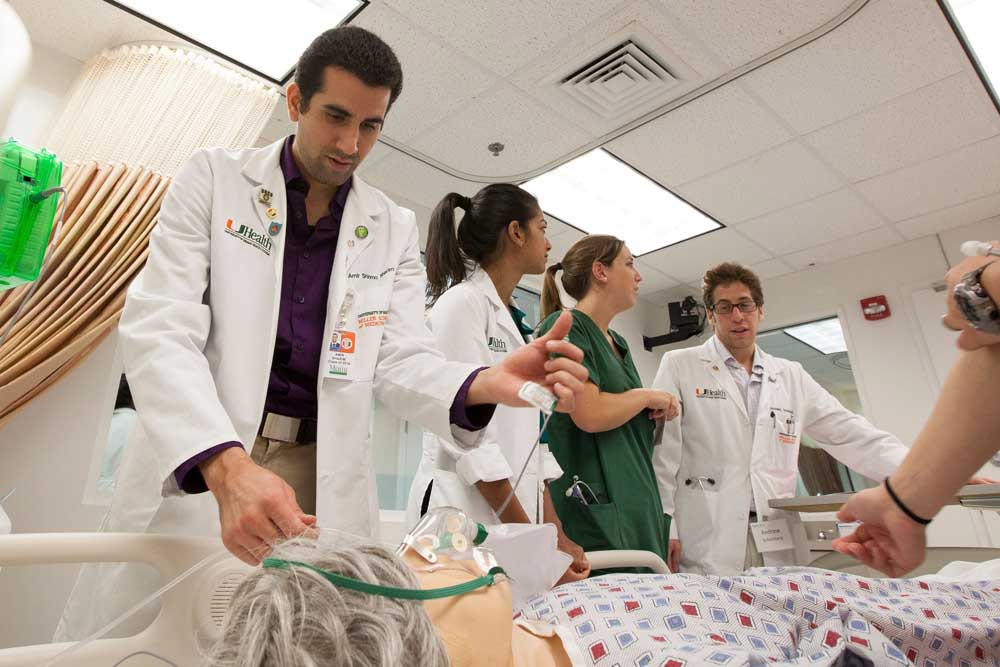Lifelike mannequins give students real-world experience
Published 12:00 am Thursday, June 26, 2014

- Courtesy University of Miami / The Miami HeraldMedical student Amir Sharim, left, works on a high-tech mannequin at the University of Miami. Some of the $45,000 simulators can cry, talk and even bleed fake blood.
MIAMI — Several University of Miami medical students crowd around a patient’s bed Tuesday morning. They are trying to pinpoint why Murray Greenberg is having trouble breathing, and they start to delegate tasks.
As the students talk over each other, the stress level in the room rises. A loud beeping noise lets them know something has gone wrong with Greenberg.
“His heart rate is dropping. His O2 is dropping,” student nurse Sara Spears says loudly.
“I’m getting worse!” Greenberg wheezes.
The students realize they need more help and try to call for a senior doctor. Greenberg’s condition is deteriorating rapidly.
Suddenly, a loud voice comes over a microphone, and the students relax. The simulation has ended.
Murray Greenberg is actually a $45,000, high-tech mannequin. The students are participating in Patient Safety Week, a program in its ninth year at the University of Miami/Jackson Memorial Hospital.
As the students worked frantically, doctors stood in a darkened control room and watched them through a large window.
All medical students and students from the School of Nursing and Health Studies spend a week reacting to real-world, high-stress scenarios before starting their third year of studies. Some of the doctor-patient interactions involve mannequins that can cry, talk and bleed fake blood, while others use actors and actresses. Students also listen to lectures and watch videos about patient safety. More than 200 students in the most recent session were undergoing training, divided into 29 teams.
A big aspect of the program is bridging the gap between future nurses and doctors and teaching them to communicate with one another.
“It makes more sense to have a team approach,” exercise organizer Jill Sanko said. One of the program’s main goals is to teach situational awareness.
Dr. David Birnbach, director of the UM-JMH Center for Patient Safety, debriefed the group after one day’s exercise. He spoke firmly but didn’t ridicule any of the students — a technique he has perfected over the years.
“It’s important to put yourself in their place,” he said. “You can’t be judgmental, and you can’t embarrass them.”
When the simulation began, Birnbach gave the students basic information about the patient and rushed out of the hospital room. He didn’t leave the students with a direct contact number, and they were too timid to ask for one. When things headed south, they had no way to reach him.
“I parachuted you into a minefield,” he told the students.
The students nodded as Sanko and Birnbach gave tips on how to react in a high-risk situation. They discussed the patient’s comfort level, previous health history and allergies.
“Just having that information can make it so much easier to communicate and work as a team,” Sanko said. She said she thinks doctors and nurses can learn from the way the military and aviation industry operate.
Both Sanko and Birnbach said students who participate in realistic patient scenarios leave with a better understanding of how important communication is.
Third-year medical student Sumit Mehta said he didn’t know what to expect, but he was surprised by how realistic the exercise was.
“When we’ve interacted with the simulators before, they’ve never responded to us,” he said, laughing.
Spears, who served as the team leader, agreed. While she felt a little prepared beforehand, she saw the exercise go downhill pretty quickly.
“It really is a humbling moment,” she said.






